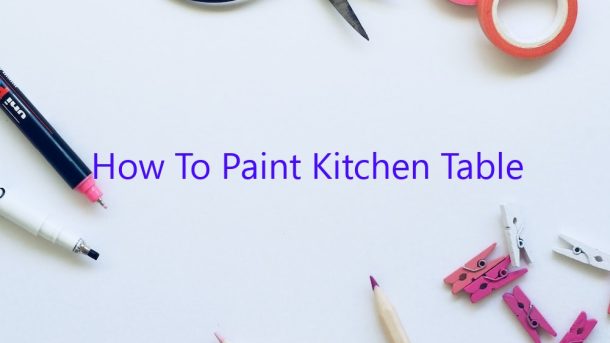If you’re looking for a way to update your kitchen without spending a lot of money, painting your kitchen table might be the solution. Here’s how to do it:
1. Remove any hardware from the table, such as pulls or knobs.
2. Sand down the surface of the table, using a medium-grit sandpaper.
3. Wipe away any dust or debris with a damp cloth.
4. Apply a coat of primer to the table, using a brush or a roller.
5. Let the primer dry completely.
6. Apply a coat of paint to the table, using a brush or a roller.
7. Let the paint dry completely.
8. Reattach the hardware to the table.
9. Enjoy your new table!
Contents [hide]
What kind of paint do you use to paint a kitchen table?
When it comes to painting furniture, there are a few different types of paint you can use. The most common type of paint to use is latex paint. Latex paint is easy to use and is available at most hardware stores. Another type of paint you can use is oil-based paint. Oil-based paint is more durable than latex paint and is available at most paint stores. When deciding which type of paint to use, consider the type of furniture you are painting and the environment it will be in. If you are painting a piece of furniture that will be in a humid environment, such as a bathroom, latex paint may not be the best choice because it can easily peel. In this case, you may want to use oil-based paint.
Do I have to sand my kitchen table before painting?
Yes, you should sand your kitchen table before painting it. This will help the paint adhere to the surface of the table and will also help to create a smooth finish.
There are a few things that you should keep in mind when sanding your kitchen table. First, make sure that you use the right type of sandpaper. You should use a medium-grit sandpaper for most surfaces. If the surface is particularly rough, you may need to use a finer grit sandpaper.
Second, always sand in the direction of the wood grain. This will help to create a smooth finish.
Finally, be sure to remove all the sanding dust before painting. This will help to ensure that the paint adheres to the surface of the table.
What is the best finish for a painted kitchen table?
If you’re looking for the best finish for a painted kitchen table, you have a few different options to choose from. In this article, we’ll discuss the pros and cons of each of the most popular finishes, and help you decide which is the best fit for your table.
One option is to use a clear coat of varnish. This will protect the paint from scratches and will keep the table looking new for longer. However, it can be a bit tricky to get a smooth finish with varnish, and it can be difficult to remove if you need to make any repairs.
Another option is to use a polyurethane finish. This is a bit more durable than varnish, and it’s easier to apply. However, it can also be a bit thick and can affect the appearance of the paint job.
A third option is to use a wax finish. This is the most traditional option, and it’s very easy to apply. However, it doesn’t offer as much protection as varnish or polyurethane, and it can be difficult to remove once it’s been applied.
Ultimately, the best finish for a painted kitchen table will depend on your individual needs and preferences. If you’re looking for maximum protection, a clear coat of varnish is the best option. If you’re looking for a low-maintenance option, a wax finish may be the best choice. Polyurethane is a good choice if you want a durable finish that doesn’t affect the appearance of the paint job.
What kind of paint do you use on a wooden table?
When it comes to painting furniture, there are many different types of paint to choose from. But when it comes to painting a wooden table, which type of paint should you use?
There are a few things to consider when deciding which paint to use on a wooden table. The first is the type of wood the table is made from. The type of wood will determine the type of paint that is best suited for the table. The second thing to consider is the finish of the table. If the table already has a finish on it, you will need to choose a paint that is compatible with the finish.
If the table is made from a light-colored wood, such as pine or cedar, you can use a latex paint. Latex paint is a water-based paint that is easy to apply and is available in a wide range of colors. It is also durable and easy to clean.
If the table is made from a dark-colored wood, such as mahogany or ebony, you will need to use an oil-based paint. Oil-based paints are more durable than latex paints and are available in a wider range of colors. However, they are more difficult to apply and are not as easy to clean.
If the table has a finish on it, you will need to use a paint that is compatible with the finish. If the table has a glossy finish, you will need to use a gloss paint. If the table has a matte finish, you will need to use a matte paint.
The type of paint you use on a wooden table will depend on the type of wood the table is made from and the finish of the table. If you are not sure which type of paint to use, consult a paint store or furniture store for advice.
How do you seal a kitchen table after painting?
There are a few ways to seal a kitchen table after painting. One way is to use a paint sealant. Paint sealants can be found at most hardware stores. Another way is to use a coat of polyurethane. Polyurethane can be found at most home improvement stores.
Can I paint over varnished wood without sanding?
Can you paint over varnished wood without sanding? In short, yes, you can. However, it is not recommended, as the paint may not adhere well to the surface and may peel or chip over time.
If you decide to paint over varnished wood anyway, it is important to rough up the surface slightly before painting to create a better adhesive surface. You can do this by lightly sanding the surface or using a chemical paint remover. Be sure to follow all the manufacturer’s instructions and warnings when using a chemical remover.
Once the surface has been roughened, you can begin painting as usual. Be sure to use a high-quality paint meant for surfaces like wood, and to apply at least two coats for best results.
What happens if I don’t sand before painting?
Most people think that if they don’t sand before painting, their paint job will turn out rough. But what actually happens if you don’t sand before painting?
If you don’t sand before painting, the paint will stick to the old paint and will be difficult to remove. The new paint will also be less likely to adhere to the surface, and will eventually chip and peel.
In order to get the best results, it is important to sand the surface before painting. This will remove any dirt, dust, or old paint, and will make it easier for the new paint to adhere to the surface.




